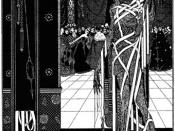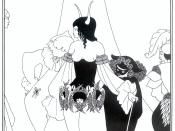Edgar Allan Poe's "The Masque of the Red Death"
Edgar Allan Poe's, "The Masque of the Red Death is an elaborate allegorical story, constructed out of a set of symbols whose meanings unite to convey the message of life and death. In this literary piece, a disease known as the Red Death is plaguing this country, causing people to die quickly and ghastly. Even though this dreadful disease is plaguing the country, Prince Prospero is happy, hopeful and delighted.
He is in denial that death can touch his life. He feels as long as he remains in control and only allows in his life what he desires. With his power he was able to control his destiny. We see this because he tried to dodge the red death disease through isolation and seclusion from the outside world, except for his selection of knights, dames and nobles.
His actions proved him to be cowardly and coldhearted. As he and his select few retreated into the castle he showed no sympathy or care about the people he ruled, locking them out of his home and not caring about their needs.
He holds a masquerade ball further portraying his gaiety. He decorates the house in fancy, royalty colors. The manner in which the castle is arranged foreshadows death, "the seventh apartment was closely shrouded in black velvet tapestries that hung all over the ceiling and down the walls, falling in heavy folds upon a carpet of the same material and hue." Not only was the color evident of death, but "the panes here were scarlet- a deep blood color". Also in this chamber was "an ebony clock" (1543) whose sound is so loud that every hour when it rings, there is silence throughout the castle. All of these images...



Good
I find this essay really interesting, I like very much the use of the vocabulary and the interpretation.
3 out of 3 people found this comment useful.